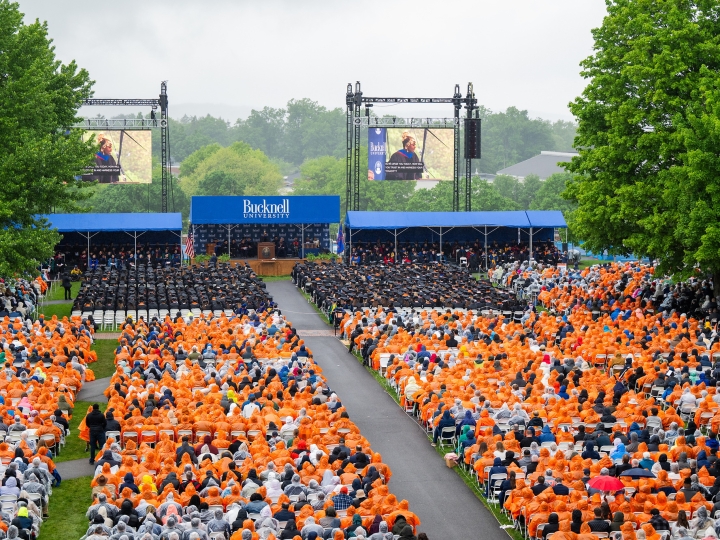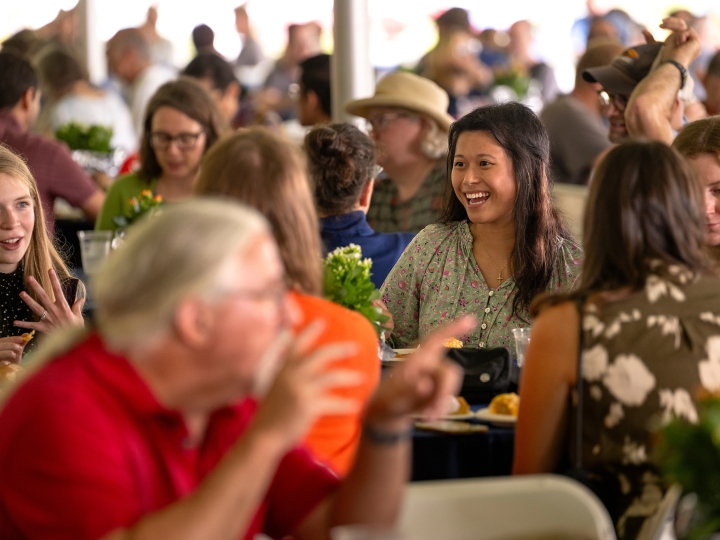
A Successful Semester, On Campus
November 20, 2020
Students wear proper face coverings as they walk across Malesardi Quad this semester. Photo by Emily Paine, Communications
Together, we made it. Amid a worsening nationwide pandemic that's forced many colleges and universities to shift to fully remote education, Bucknell completed its fall semester classes on Friday, Nov. 20, offering in-person instruction to students on campus.
Nearly 3,400 students came to campus for the start of classes Aug. 17, with more than 300 electing to study remotely. While there were several positive COVID-19 cases over the next three months, campus remained open until the end thanks to a rigorous testing regimen supported by GENETWORx, strong protocols for isolation and quarantine, and other preventative actions.
It may have been the most unusual on-campus experience the University has seen due to required regular testing and behavioral public safety measures, but students appreciated the opportunity to be back on campus, says Wilder Brice '22, Bucknell Student Government president.
"The ability to remain on campus for the entire semester is certainly a privilege right now," Brice says. "Many students prefer the classroom environment and are grateful for the opportunity to be in a classroom. Considering the time we spent remote in the spring semester of 2020, I think we feel lucky to be able to return to the classroom."
Checking COVID at the Door
Implementing one of the nation's most aggressive testing programs was a major factor in Bucknell's on-campus success. Students were required to produce two pre-arrival negative COVID test results and asked to self-quarantine prior to arrival. On-campus faculty and staff were also required to get tested before students returned.

More than 10,000 signs hung around campus reminded community members to adhere to health and safety protocols. Photo by Emily Paine, Communications
Students and on-campus employees were tested again periodically every 10-to-14 days throughout the fall semester, and more frequently during the few instances when positive cases showed moderate spikes.
"Having two negative test results before you could move in along with the suggestion that people self-quarantine at home, I think, was a big part of our initial success," President John Bravman says. "Of course our periodic testing was part of it, too. A lot of schools opted to do symptomatic testing only; Bucknell did full-blown, full-population testing on a periodic basis."
Students who tested positive were moved to off-campus isolation housing secured by the University, as were close contacts identified through the University's own campuswide contact tracing program.
A Community Commitment
The biggest key to a successful semester may have been the commitment from students in honoring the Community Responsibility Agreement they signed in order to move back on campus. It asked them to engage in behavioral public safety measures intended to mitigate the spread of the virus, including physical distancing, face covering, respiratory etiquette, proper hand hygiene, honoring COVID-19 signage and promptly reporting symptoms. Travel restrictions also required students to remain within 30 miles of campus, and the semester schedule was adjusted to eliminate fall break and to end instruction before Thanksgiving to keep students on campus.
The University recognized early that it needed to do more than just establish those guidelines, says Dr. Catherine O'Neil, medical director of Bucknell Student Health. Students would need to find support and role models among their peers to reinforce their commitment.
"From our beginning planning, our biggest concern was having buy-in on campus for herd health," O'Neil says. "The idea is that everyone is important, everybody needs to be supported, especially students who were coming here for the first time and didn't have friend groups already established."
To facilitate that support, the University established the "My Herd" initiative — a set of microcommunities that focused on shared accountability and health monitoring. Every student was assigned to a group of about 10 peers from their class year called a "herd," which connected frequently with a volunteer staff or faculty leader.

Students embracing guidelines such as face covering played a crucial role in completing an on-campus semester. Photo by Emily Paine, Communications
The campus community also received regular communication from Bravman and other University leaders to reinforce adherence to mitigation measures — particularly when it appeared compliance may wane. Brice says those messages helped students remain focused on their desire to stay on campus.
"The University's communication to students throughout the semester with emails, signage around campus and My Herd reminders certainly played a role in helping students to engage in measures to mitigate the spread of the virus," Brice says. "However, I think the informal patterns of communication ultimately played the biggest role. It is hard not to see the case outbreaks at peer institutions or read about the national case count increases without thinking about how easily Bucknell could be in a similar situation."
Preserving the On-campus Experience
Of course the University had its own commitments to live up to as well. Amid the far-reaching new safety protocols, the University still had to deliver the deeply personal, residential education experience that led its students to choose Bucknell. Preparations began as soon as the University sent students home during the early days of COVID-19 in March.
Most faculty worked with members of the Library & Information Technology and Teaching & Learning Center over the summer to learn how to best employ course management and videoconferencing software as they adapted to hybrid teaching models that incorporated both in-person and online components.
"We are a residential university. We are a living and learning community and we had to rethink everything about how we go about doing business," says Provost Elisabeth Mermann-Jozwiak. "That process started in May. It was enormously challenging. Nobody had done this before. I'm really impressed with how the community came together to make this work, and I'm very proud of the fact that we’re still here at the end of the semester."
It wasn't just the delivery model that had to be adapted, but the classrooms themselves. Spaces adapted for teaching included outdoor tents set up around campus, the 1,200-seat Weis Center for the Performing Arts and the Christy Mathewson-Memorial Stadium, among others. Indoors, seating was rearranged for maximum distance between occupants, and cleaning supplies were provided for students and faculty to wipe down spaces after classes adjourned.

Newly installed picnic tables throughout campus gave students options for studying and dining outdoors. Photo by Emily Paine, Communications
While it was unlike any other semester, faculty and students came together to make it work, and students were able to stay in residence until the semester's planned conclusion. That made Brice extremely proud of his fellow Bucknellians.
"The student body has proven to me to be responsible, thoughtful and understanding of the severity of the health crises we are in," he says. "It's astonishing to me the level of maturity shown over the fall semester. I think it speaks to the incredible connection students have to the University."
Bucknell's faculty may also have come away from the experience as even more skillful, engaging educators.
"I had a meeting recently with the department chairs and in the midst of the most challenging and difficult semester, I asked them, 'What is the silver lining?,' " Mermann-Jozwiak says. "They said, 'We learned a lot about ourselves. We learned about teaching. We learned about online education and how in-person education can be enhanced by online components. We don't want to go fully online, but we want to see how we can learn to use other technologies in our instruction.' "
And ultimately the Bucknell campus community learned that it could come together to overcome an unprecedented challenge.
"In general, people have been very supportive of our aggressively safe stances, and it's been rewarding to show that yes, we can do this," Bravman says.
Bucknell plans to return for another on-campus semester Feb. 1.

